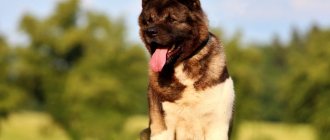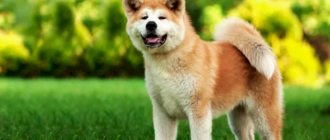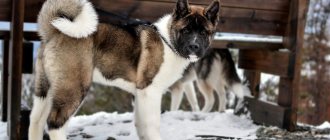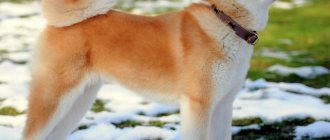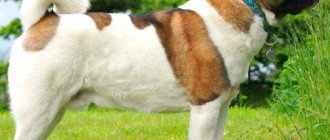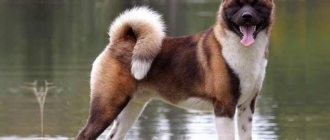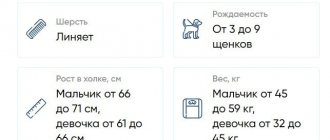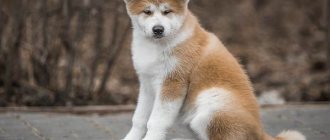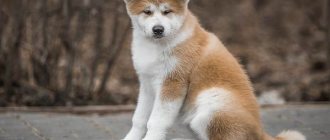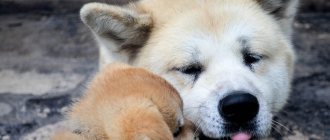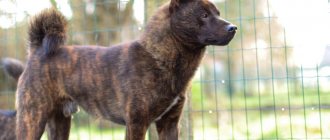The closest relative of the faithful Hachiko, the American Akita dog breed has absorbed the character traits of real samurai. A brave, aggressive, but at the same time friendly dog with a colorful exterior, without hesitation, will protect the owner or his property, go hunting or entertain children.
However, the dog’s fighting and hunting background requires serious training and proper upbringing, so before purchasing an American Akita, you need to familiarize yourself in detail with the description of the breed, its characteristics and maintenance features. This will allow you to fully realize your pet's potential and avoid possible problems.
Description and origin
Long-haired Akitas or long-haired Akitas are not distinguished as a separate breed. They appear when crossing standard-coated parents that have a recessive gene for long hair. It appears in 20-30% of offspring.
In the 1930s, the breed was recreated and crossed with Akita-like breeds, including the Sakhalin Husky. It is believed that Akitas inherited the long-haired gene from them. Akita Inu are Spitz-shaped dogs, strong and large .
Sex differences are pronounced. Long hair is more visible on the ears, collar, back of the legs and tail. Long-haired Akita Inus meet the standard.
| Girls | Boys | |
| Height | 61-66 cm | 66-71 cm |
| Weight | 32-45 kg | 45-59 kg |
- The head is massive and wide. The transition from the forehead to the muzzle is pronounced, there is a small groove on the forehead.
- The eyes are deep-set and triangular.
- The nose is preferably black.
- The lips are pressed to the teeth, black and dense.
- bite or straight bite.
- The ears are set wide, erect and hard. Slightly tilted over the eyes.
- The neck is strong, without folds, gradually expanding towards the withers.
- The chest is wide and voluminous.
- The withers are not pronounced, flowing into a strong, straight back.
- The belly line is quite toned.
- The tail is thick, curled into one or two rings.
- The limbs are strong and muscular, heavy. The brushes are almost round, arched, with thick pads.
By the way!
There is an opinion that the long-haired is also useful for short-haired Akitas , because the quality of the fur depends on it. Theoretically, it is possible to exclude all its carriers from breeding - this will reduce the likelihood of long-haired dogs appearing in future litters. But this will negatively affect the undercoat - its thickness, density and ability to retain heat. So fluffy dogs are beneficial for the breed as a whole.
The frequency of birth of long-length is the same in Akita Inu and BYAS.
Photo
Next you will see how representatives of this breed look in the photo:
Character
They belong to the class of companion breeds. Bred for hunting. They do not bite or rush at strangers unnecessarily, but they growl or bark menacingly. They can be aggressive with other animals. Show leadership and dominant character traits. Stubborn and self-sufficient.
Not suitable for novice dog breeders because they require persistent and constant training. Proper education should be aimed at developing breed qualities - poise and nobility. Newbie mistakes lead to aggressiveness and unstable behavior.
Akita Inu - Japanese Spitz-like dog
Akita Inu puppy with a soft toy in his paws Akita Inu is an old breed whose age can be measured in centuries. It gained worldwide fame not so long ago due to the closed nature of Japan and their commitment to their traditions. This breed is recognized as a national treasure of the country, and therefore has not left its borders for many years.
The ancestors of the Akita Inu moved through the Odate Mountains for a thousand years, preferring to hunt wild boars and bears, but in the 18th century they reached the imperial court, where they subsequently began to be bred.
The Japanese forbade commoners from even looking at the dog, as it was considered god-like. Each individual was assigned a servant who observed the rituals of communicating with the dog. Interesting information! The Japanese are still trying to keep the breed pure, creating clubs for breeding Akita, and monitoring the fate of their pets.
Features of wool
Recognized color as standard Akita Inu:
- Tawny or red, with urajiro . Shade - from soft peach to rich. Urajiro - white or light areas of fur on the inner surfaces of the paws, belly, throat and muzzle.
- White – without marks or transitions to another color.
- Tiger – black, red or silver.
Akitas shed twice a year. After the active stage of shedding, the dog needs to be thoroughly combed and washed. It is not recommended to wash your dog more often; the three-layer coat protects the dog from dust.
Long-haired Akitas are brushed 1-2 times a week. Every day during shedding. To do this, use a comb or slicker brush. Before combing, you can wet the dog with water or a special means for easy combing. The coat tends to become electrified, usually in winter. It is recommended to use antistatic spray.
What are they?
These dogs are not specially bred, but they have their fans. Those who keep long dogs note the similarity of their characters with ordinary Akita Inu : dominance, loyalty to the owner, love of active entertainment, developed intelligence and instinct for protecting the territory.
A long-haired dog will become your faithful friend and guard - provided that you give him enough attention and raise him well. His “shaggy feature” does not affect household needs, health and life expectancy - he is the same as everyone else, just fluffy. The specific features of the exterior only complicate the care of the coat.
How long do they live and what diseases do they suffer from?
- Long hair does not affect the health of the animal in any way; it is not a deviation. Long dogs are susceptible to the same diseases as standard Akita Inu. Typical diseases include deformation in the musculoskeletal system. This is a hereditary or acquired disease, typical for most large dogs - shepherds, chow chows, Labradors. It manifests itself with an unbalanced or unhealthy diet, or increased physical activity.
- Puppies are sometimes born deaf. At 6-8 weeks, the lower or upper eyelid may roll up.
- By allergies it is more correct to understand individual intolerance to foods. Akitas are fed premium or super-premium food; many breeders use fish food. If the diet is not suitable, vomiting, lack of appetite, diarrhea and constipation occur. The food is gradually changed to another.
- Gastric volvulus occurs (less commonly) from improper feeding or genetic predisposition. It is recommended not to give your dog physical activity after feeding, at least for half an hour.
- More often than standard Akitas, Long Dogs suffer from sunstroke and overheating. In the summer, walk your dog only early in the morning and in the evening. If you can't, at least stay in the shadows. It is also better to move feeding to late evening. The dog's coat needs to be moistened periodically.
Important!
Akita Inu lives quite a long time for its size - up to 15 years. But subject to proper care and nutrition.
Mating
American Akitas become sexually mature at 8 months. But mating is carried out no earlier than 1.5 years. The animal's body must be fully formed in order to bear viable and healthy offspring.
Dogs are introduced several weeks before the start of heat so that they get used to each other. At the appropriate time, the bitch is brought into the dog's territory.
On average, pregnancy lasts 60-62 days. If there are few puppies, the period may be slightly shortened. A litter usually produces 6-8 babies.
Care
The dog is accustomed to grooming procedures from puppyhood . If you do not do this right away, the adult dog will not be able to be held in your hands, and it is difficult to hold by force due to the strength and weight. Place the dog on a high place, such as a table. This way the inspection will be more thorough. Give your dog treats after handling.
- You cannot shave an Akita's fur. This disrupts the structure of the layers and spoils the dog’s appearance. But the fringes on the tail, paws and ears can be trimmed slightly. With regular brushing 1-2 times a week, the dog's hair does not mat.
- Nails are trimmed once a week with guillotine shears and then filed. In summer, less often, because the claws themselves wear off on the asphalt. Akitas have a fifth toe on their front paws; don’t forget about it when trimming their nails.
- Legs of lamb or moss can be given to clean teeth. Teeth are examined every week and cleaned once every 2 weeks with a special brush and toothpaste. The formation of tartar should not be allowed, because it is removed under ultrasound anesthesia.
- Special wet wipes and lotions are sold for cleaning ears. Soak cotton swabs in the lotion and gently clean the ears. Clean once every 7-10 days.
Training
The peculiarity of the American Akita breed is also manifested in training. The process of training and training an American Akita will take a lot of time, effort, perseverance and patience. It’s good if a professional does the training. The dog most likely will not want to unquestioningly carry out the same command many times if, after analyzing the situation, it understands that the expenditure of effort and energy is useless for it. This is a mood dog. When he doesn’t want to do something, it’s almost impossible to force him. If the owner is not ready for such difficulties, then perhaps another dog breed that is more accommodating should be considered.
The dog owner will need to learn to understand it better and find a common language with his pet. This breed does not like monotonous, monotonous training for many hours. It is recommended to conduct training in the form of a game. And if the dog gets tired or bored, you can distract him with a toy or give him some kind of treat.
What you should absolutely not do is yell at the dog or, even worse, try to use physical force on it. The dog may become angry with its owner and lose respect and trust in him. It will be extremely difficult to regain authority. As a result, if you stop controlling the dog and don’t deal with it at all, leaving everything to chance, there is a huge risk of raising a bully and an uncontrollable animal.
Food or natural food
A natural diet requires variety. When choosing such food, be prepared for the fact that the products take up a lot of space. Food should be fresh and prepared for 1-2 servings. So you will have to stand at the stove often and for a long time.
Alternate beef, chicken, turkey, offal - 1-2 times a week. Akitas cannot eat pork. The meat is not cooked for a long time - about 20 minutes, offal - 1-1.5 hours. Once a week they give raw meat, without bones.
You can diversify your meat menu with sea fish, boiled, boneless , 1-2 times a week. Eggs – once a week – ½ part. Cook porridge in bone broth – rice, buckwheat – 1/3 part.
Vegetables - carrots, pumpkin, less often cabbage, fresh carrots and cucumber - ¼ or 1/3 part. The portion is 4% of the weight of an adult dog, 10% of the weight of a puppy. Premium segment food provides dogs with essential nutrients and vitamins. A practical option for apartment dogs.
Choosing a puppy
- Find a good breeder who cares about their pets. A good breeder will ask where and how the dog will be kept, ask for your number and give you his own. They don't mind if you call with questions about the dog. Ask the breeders for passports, pedigrees of the parents, awards for participation in exhibitions, if any. The better the puppy's parents, the more likely it is that the puppy will be beautiful, healthy physically and psychologically. It is also useful to find out about your parents’ ancestors, look at their passports, and learn about their victories at exhibitions.
- The puppy must have a passport with vaccination records and a birth certificate. Subsequently, the metric is exchanged for a pedigree, without which participation in exhibitions and breeding is impossible. All data can be checked on forums and in kennel clubs.
- Long hair sometimes becomes a disqualifying factor for participation in exhibitions. But if the puppy is healthy, has all the external signs and behavior of the breed, then it can be used for breeding. On the other hand, other breeders may not pay attention to your pet, since they are looking for the best representatives, champions and exhibition participants for their offspring.
- The puppy is picked up at 7-8 weeks of age. No breeder can guarantee that the dog will be perfect.
- Examine the puppy. The eyes should not water, there should be no unpleasant odor from the ears and mouth. The ears are already raised or standing still.
- The paws are parallel, the puppy stands confidently. The tail is curled over the back, sickle-shaped or completely curled.
- At this age, urajiro already manifests itself. Or it’s still black, but then it changes to white.
- Don't choose puppies that run and hide. It’s good if puppies show interest in a person, come up and sniff.
Long-haired Akita Inu are excellent companions for walking, hunting and living. Despite their cute appearance, they are fearless and can be aggressive towards other animals. They need special training and education so as not to become a burden for the owner in the future.
History of the breed
The American Akita, or large Japanese dog, comes from the Land of the Rising Sun. Akita Inu was the name of the dogs that gave rise to the breed. In the 16th and 17th centuries, Akita Inu were engaged in hunting and guarding activities.
But new times require new entertainment, and at the turn of the 19th and 20th centuries, dog fighting began to become extremely popular in Japan. This breed did not escape the gladiatorial fate either.
Owners of fighting dogs did not miss the opportunity to “improve” their fighters by crossing them with other large breeds. The blood of mastiffs and German shepherds brought to the islands seriously affected the purity of the Akita Inu breed.
After a dog show held in the Japanese capital in 1914, when it was difficult to find purebred representatives of the breed. The government declared these dogs natural monuments and legally prohibited crossing them with other breeds.
Breeders and breeders from the Land of the Rising Sun are hard at work restoring the Akita Inu breed. The heyday of the breed was interrupted by World War II. All service dogs went to the front line. The Japanese did not spare themselves, but there was no question of taking care of the dogs.
By the time Japan surrendered in 1945, the number of Akitas had dwindled to just 20 , and American soldiers were bringing cute puppies across the ocean. Subsequently, it was these kids who became the founders of a new American breed - the American Akita.
Known from the movie, Hachiko is a representative of the Akita. The film is based on a true story.
The new breed in the USA, without further ado, was called the large Japanese dog. American breeders immediately set about improving the breed. Of course, without any coordination with Japanese colleagues. Island breeders tried to establish cooperation with the Americans, but did not find support.
The Japanese banned the export of Akitas to the United States, but American breeders were not impressed by these measures; their work on the breed continued. The more time passed, the more the American version of the Akita differed from the Japanese.
The American Kennel Club was created in 1956, but it was not officially recognized by the American Kennel Club until 1972. The conflict between American and Japanese breeders continued for a long time. Only Japanese dogs have received international recognition. The American Akita was recognized by the Fédération Cynologique Internationale only in 2000.
In Russia, American Akitas are a rare breed. But it is worth noting that V.V. has a pet of this breed. Putin.

